When I think “scraps,” the last thing that comes to mind is goldwork embroidery on velvet. But I’m not sure what else to call this! It’s a remnant, certainly – the remains of something never quite finished, and then apparently somehow damaged… it’s more than a scrap, though less than whole. But it’s still neat to look at and wonder!
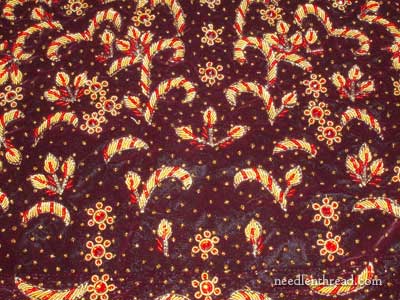
As “scraps” go, this is a fairly large one – it’s a piece of velvet on which is worked a scattered pattern of swirls and flowers in gold and red beads, with a stippled background of small gold-colored beads. This was sent to me Magpie over at Magpie’s Mumblings, with a little note saying that as she was cleaning up (she’s moving!), she came across the piece and thought of me. Thanks, Magpie!!
I always think it’s fun to examine pieces like this, so I thought I’d share my musings with you.
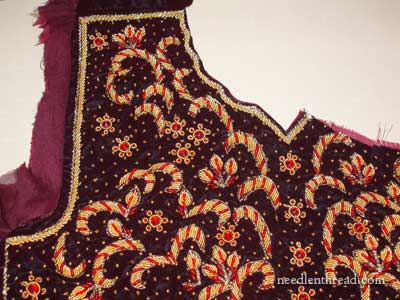
First off, what is it? It’s the front bodice piece of something that was never finished, methinks. The front left shoulder is missing – looks like it was cut off – and the garment obviously never completed. I’m figuring it is Indian in make, from the overall design of the neckline, the banded waist, and so forth. It brings to mind a very dressy choli, though not quite as short as some, so perhaps that’s what it was intended to be. But maybe not – it would make a rather heavy top, with the velvet layer, the lining, and the beads and goldwork.
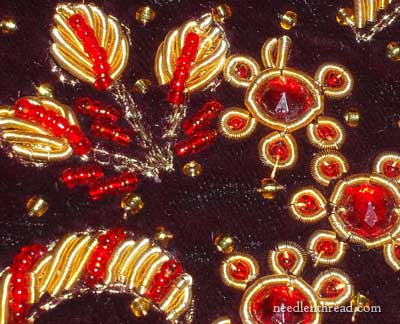
The metal threads on this – purls – look like Sadi threads, and the larger beads in the center of the each flower element (as well as the small red seed beads) are plastic.
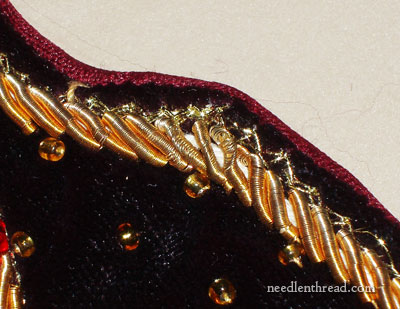
Around the neckline, you can see that the purls are sewn over a thick white cotton cord. The edge of every element made out of the purls is outlined with either a chain stitch or a zig-zag chain stitch, using a synthetic gold thread, and you can see the zig-zag chain stitch pretty well in the photo above.
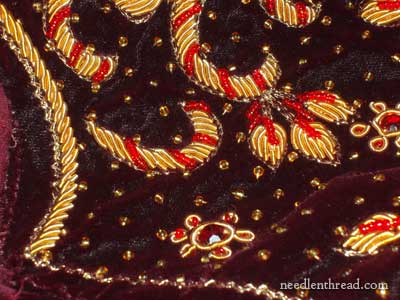
So it’s a little mystery piece: why would someone go to the trouble of making this much of the piece, and not finish it? Why the cut off shoulder? What would the whole outfit have looked like? Was the hand embroidery done by one person, making something for an individual, or was it some kind of commercial piece made in a factory, workshop, or even sweatshop? It was certainly made by hand – this type of metal work can’t be done by machine – with synthetic metal and metallic threads, and it was certainly intended to be part of the bodice of something that would have looked very rich, with the velvet background and the gold embellishment. But beyond that, in the words of Schultz, I know nothing!
Any speculation? Any suggestions for use? I’m all ears!
Thanks again, Mary Anne, for thinking of me, and for making my day! It was a fun surprise!







I wonder if maybe it wasn’t up to the standards to be sold as a finished item, so they cut off the shoulder so it couldn’t be used? Or the beading was done and then the project abandoned and later a bit of fancy fabric was wanted for another project (doll clothes, ornament, etc) and so a bit snipped off. In any case – it is very pretty.
Interesting artifact. Could you please post a picture of the entire piece? It’ll help identify it.
I see a pretty pillow
Yes,definitely Indian..or may be even Persian.
Remember my embellished skirt and blouse,Mary?
http://deepashome.blogspot.com/2009/01/embroideredembellished-indian-attire.html
The work on this piece is much much better than on that skirt.It is known by the name Zardozi work here.
I think you are correct about the ethinicity especially with a mixture of plastic beads and real gold thread.
Also the design appears middle eastern
My guess is that it’s a portion of either of woman’s salwar kameez or a man’s vest (i.e. for a wedding garment) with North Indian origins. In Southern India, women traditionally wore saris, with elaborate fabric weaving versus the gold work sewn on like this. And it’s definitely too hot in Southern India to wear velvet!
In India, you buy your dress (such as salwar kameez and saris) as decorated cut pieces of fabric and then take it to your tailor to have sewn. I doubt this was done by machine but it would likely have been done in a “workshop” atmosphere, with the embroiderers working side by side.
I know what I’d do with it. I’d portion it out as central patches for a Christmas themed crazy quilt. With other black fancy fabrics around it, and the black patches embellished in green,red, and gold (but not necessarily goldwork), it would be a stunning wall hanging.
Dear Marymentor:
While I doubt that they celebrate Christmas in India, this surely looks like a Christmas offering to me ? (Candy Canes ?)..Judy in Pittsburgh
I have to laugh, Mary, because I can just see all my UFO’s being wondered about someday just as well!
I think it could have been a theatrical piece. Maybe it was damaged on purpose…a piece removed for a keepsake/scrapbook of that costumer’s past works. Kind of like an artist’s portfolio.
Just a thought!
The first thing I thought of was Christmas, too! You could use parts of it to decorate a stocking, such as the top cuff, or make pillows. With the leftover bits you could make little candy cane ornaments. How big is it?
I can’t imagine the “story” behind this bit — yes, intended for a garment. I think such pieces are purchased pre-embroidered and turned into a garment by the individual. I remember seeing such pieces in my meanderings. I find it interesting to note how the quality differs in the gold used in Indian pieces as opposed to English goldwork threads…
I think it’s pretty funny that people are thinking of Christmas – the first thing I thought of was a Renaissance faire costume (especially given that it is velvet, I think it is unlikely that it is Indian in origin).
Also, tons of people in India are Christians, and some have been Christian since the first century BC, so Christmas is definitely celebrated there! 🙂
A me ha fatto pensare ad una maschera o un gran ballo. Forse un momento di stizza, la ricamatrice ha tagliato la spalla e non ha finito il lavoro, chissà….Bacioni a te Maria
Yay – I’m glad you received it Mary! It’s been in my stash for awhile and I never could figure out what to do with it (nor can I remember where I got it). I know you like goldwork so thought you might like to have it to use in something, or just to study.
I know Magpie Mary Anne and she is great about sharing and thinking of what others would like. Nice of her to share. I think who ever cut the shoulder off was not the person who put all the effort into making it. Can you imagine all the time invested and then cutting it up?
Deb
My first thought that it was a “cast-off” from a wardrobe/costume shoppe. If you look at show such as “The Tudors” and “The Borgias”, look at the work done on their costumes, much of it is not factory, and in “The Borgias” especially, it looks as if it was embroidered, not trim sewn onto fabric. Maybe this piece was not required (for whatever reason, the garment didn’t fit, look right, the actor wasn’t needed, etc,).
The portion cut off looks almost square, so maybe they made a little pillow, book cover, or other pretty thing off of it, or even a sample for their portfolio.
I would use it as center piece either in a piece of clothing or maybe a pillow or something for my home.
I am just writing about needlework during the Renaissance. Anything with gold or silver thread held an special cachet, and valuable gems adored many of the gorgeous costumes. It certainly means that ‘They wore the value of their entire estates one their back’ is a literal truth, and when in debt, the pawnshop provided a helpful way to raise cash with little stigma. A sleave with gold thread, made of silk velvet would raise a staggering sum. The gowns were made, even for sovereigns, to be interchangeable: this gave one much greater and longer use of the same basics without appearing twice in any confection, and much as people buy Bentley today, clothes, particularly gold and silver brocade witht the finest stitching and craft, advertised the power of the wearer. ‘I am rich enough to wear this, thus my armies are vast.’ It was 15.08a genteel activity acceptable indeed desirable in any young child, woman or elderly dowager. I’d better go pawn my sleeves! Hope that gives some background. I am sobbing at what my mother and grandmothers etc have just chucked out. It is the WORK on the these stunning creations that is so hard/often imposssible to find. I am a basic cross sticher myself! Leonie F May 28